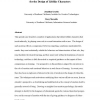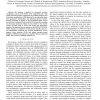46 search results - page 2 / 10 » The EMOTE model for effort and shape |
AAI
2005
13 years 4 months ago
2005
This special issue describes a number of applications that utilize lifelike characters that teach indirectly, by playing some role in a social interaction with a user. The design ...
ICALT
2008
IEEE
13 years 11 months ago
2008
IEEE
Research on modelling affect and on interfaces adaptation based on affective factors has matured considerably over the past several years, so that designers of educational product...
ICANN
2007
Springer
13 years 8 months ago
2007
Springer
Abstract. In this paper, we will address the endeavors of three disciplines, Psychology, Neuroscience, and Artificial Neural Network (ANN) modeling, in explaining how the mind perc...
FGR
2011
IEEE
12 years 8 months ago
2011
IEEE
— We propose a method for automatic emotion recognition as part of the FERA 2011 competition [1] . The system extracts pyramid of histogram of gradients (PHOG) and local phase qu...
ISBI
2009
IEEE
13 years 11 months ago
2009
IEEE
Biological shape modeling is an essential task that is required for systems biology efforts to simulate complex cell behaviors. Statistical learning methods have been used to buil...


